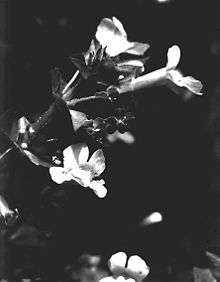Mimulus michiganensis
| Mimulus michiganensis | |
|---|---|
 | |
| Scientific classification | |
| Kingdom: | Plantae |
| (unranked): | Angiosperms |
| (unranked): | Eudicots |
| (unranked): | Asterids |
| Order: | Lamiales |
| Family: | Phrymaceae |
| Genus: | Mimulus |
| Species: | M. michiganensis |
| Binomial name | |
| Mimulus michiganensis (Pennell) Posto & Prather | |
Mimulus michiganensis (formerly Mimulus glabratus var. michiganensis)[1][2][3] is a rare species of flowering plant in the lopseed family, known by the common name Michigan monkeyflower. It is the only plant endemic to the American state of Michigan,[4] where it occurs only in the Grand Traverse and Mackinac Straits areas.[5]
It is restricted to a specific type of habitat, and one that is being degraded and lost to development. It was federally listed as an endangered species of the United States in 1990.[6]
Description
The Mimulus michiganensis aquatic or semi-aquatic plant produces matlike clumps of decumbent stems up to 36 centimetres long. The stems root at nodes that come in contact with wet substrate and there send up new stems. Many clumps containing hundreds of stems may all belong to a single genetic individual.[5] The oppositely arranged leaves have toothed edges. Flowers grow from the leaf axils, each borne on a pedicel often longer than the leaves.[3]
The tubular yellow flower is 1.6 to 2.7 centimeters long and has a wide mouth with two lobes on the upper lip and three on the lower lip. The lower lip and throat may be speckled with red. The lower lip is coated in yellow hairs. It serves as a landing spot for pollinating insects,[3] however, the plant produces little viable pollen, so it is likely that most of the reproduction is vegetative via stolons, rather than sexual via seed.[6] Biological dispersal then takes place as pieces break off and float downstream.[3] Blooming occurs in mid-June through mid-July, and sometimes extends into August,[6] or rarely September[5] or October.[3]
Distribution
Mimulus michiganensis is found almost exclusively on the shores of the Great Lakes, or what were ancient shorelines.[6] It grows on lakesides and stream banks in wet, saturated soils or in very shallow water.[6] It requires cold, clear flowing water in full sunlight.[5] The substrate is sand covered in muck.[5] It also appears to require a narrow pH range that is slightly alkaline.[3] The habitat is the edges of forests dominated by northern white cedar (Thuja occidentalis). Other plants in the area may include touch-me-not (Impatiens biflora), water forget-me-not (Myosotis scorpioides), watercress (Nasturtium officinale), wild mint (Mentha arvensis), and marsh marigold (Caltha palustris).
There are seventeen known occurrences of this plant, but two of these have not been observed recently.[3] The largest occurrences are at Glen Lake, Burt Lake, and the shoreline of Mackinac County.[3] It can be found at Sleeping Bear Dunes National Lakeshore.[6] Many of the occurrences are on privately owned land.[6] One population was located after a biologist found a specimen used as a garnish on his plate at a restaurant.[6]
The plant has proven resilient at times; it has been noted to persist in dry conditions and after being mowed when it appeared in the lawn of a home.[7] It can also live without sunlight in darker areas of the forest understory, albeit in sterile form.[3]
- Conservation
This rare plant depends on a continuous flow of cold, clear spring water. It is threatened by human activities that disrupt this flow, such as groundwater pumping and diversion and natural processes such as storms and periodic high lake levels. Degradation of the habitat is also a threat, and may come from residential development and recreational use. Development has caused the extirpation of at least three occurrences.[6] Conservation efforts will require direct protection of plants and prevention of alterations in the local water regime.[3] Because the plant probably uses cloning as its primary method of reproduction, the number of genetically different individuals is probably low, making populations more vulnerable.[5]
See also
- Category: Flora of Michigan
References
- ↑ Posto, A. L. and L. A. Prather. (2003). The Evolutionary and Taxonomic Implications of RAPD Data on the Genetic Relationships of Mimulus michiganensis (Comb. et stat. nov.: Scrophulariaceae). Systematic Botany 28:1 172-8.
- ↑ Mimulus michiganensis. GRIN.
- 1 2 3 4 5 6 7 8 9 10 Mimulus michiganensis. Michigan Natural Features Inventory.
- ↑ Mimulus michiganensis. MNFI Rare Species Explorer.
- 1 2 3 4 5 6 Mimulus michiganensis. The Nature Conservancy.
- 1 2 3 4 5 6 7 8 9 USFWS. Determination of endangered status for Mimulus glabratus var. michiganensis (Michigan monkeyflower). Federal Register June 21, 1990.
- ↑ Mimulus glabratus var. michiganensis. Center for Plant Conservation.
External links
- USDA Plants Profile — Mimulus michiganensis (Michigan monkeyflower)
- Species Profile for Michigan monkey-flower (Mimulus michiganensis)
